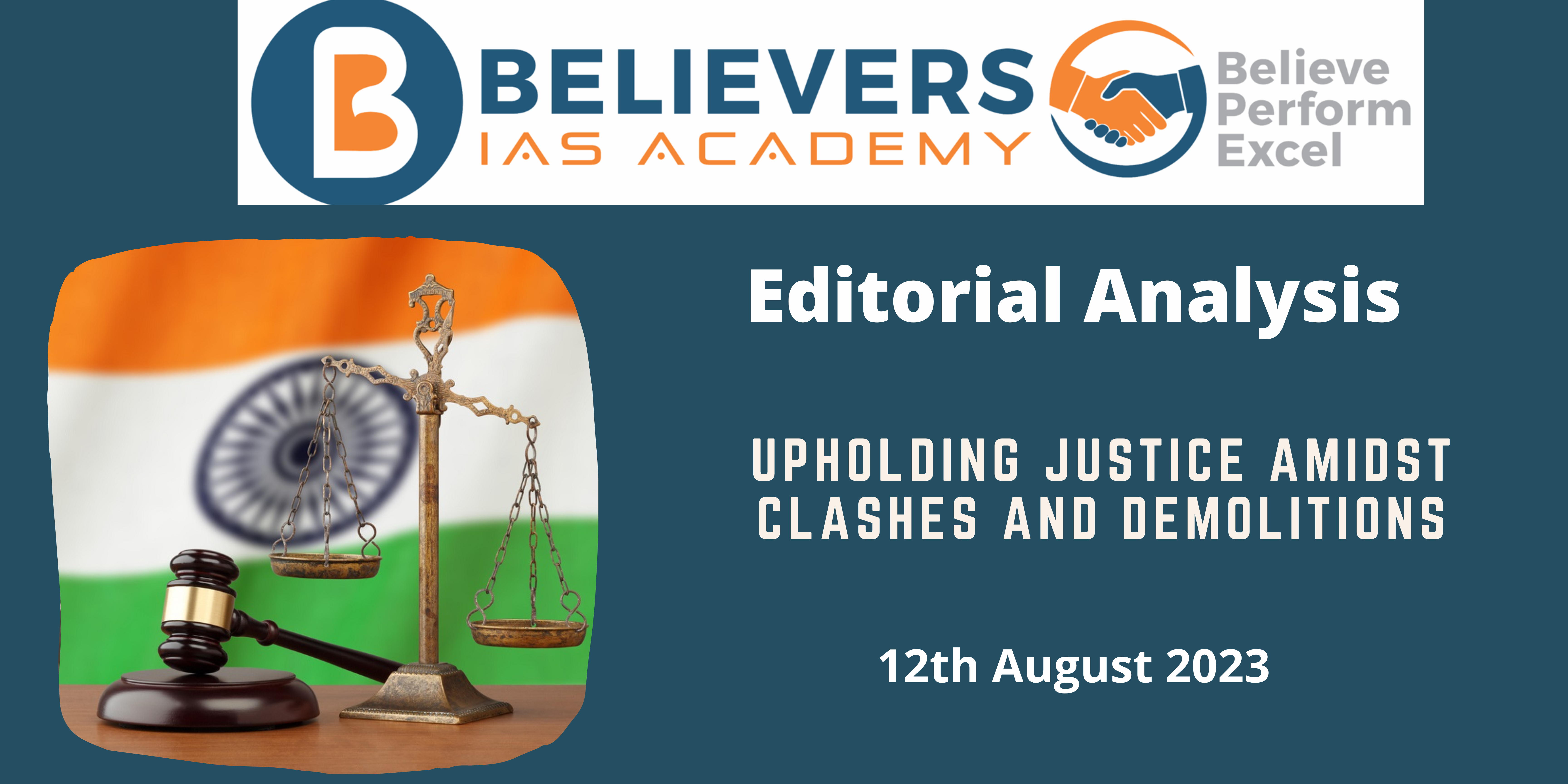Upholding Justice Amidst Clashes and Demolitions
Context:
The recent clashes between Hindu and Muslim communities in the districts of Gurugram and Nuh, Haryana, have sparked concerns about the administration’s ability to restore law and order and maintain peace. The clashes have led to loss of life and destruction of public property, further escalating tensions.
Relevance:
GS – 01 (Secularism, Communalism, Salient Features of Indian Society)
GS-02 (Judiciary)
Prelims:
- Moplah rebellion of 1921
- Partition riots of 1947
- Democracy
- Secularism
- Human Rights
Mains Question:
Discuss the challenges posed by recent communal clashes and the role of the judiciary in upholding justice and preserving constitutional values. (150 words)
Dimensions of the Article:
- Uneven Responses Highlight Disparity
- Courts’ Role and Responsibility
- The Thin Line of Judicial Authority
- Judicial Nominees and Executive Delays
- High Court’s Assertion and Unanswered Question
Uneven Responses Highlight Disparity
- In analyzing the prevailing situation, it is evident that competent administrations are not the norm in today’s India.
- Drawing parallels from Uttar Pradesh, the Haryana government has resorted to abrupt demolitions of houses, specifically those suspected to be linked with the violence.
- This unilateral approach has raised questions about the government’s intention, as the demolitions disproportionately target the Muslim community, leaving many homeless and disregarding the rule of law.
- The constitutional principle of Article 14, ensuring equality before the law, is being compromised for political gains.
Courts’ Role and Responsibility
- Amidst the chaos, the role of the courts, entrusted with upholding the Constitution and safeguarding rights, becomes crucial.
- However, their response has been tepid at best. When confronted with the rampant demolitions in Uttar Pradesh, the Supreme Court’s reaction lacked the vigor needed to address the situation comprehensively.
- Instead of raising critical inquiries into the selective targeting and hastened demolitions, the Court merely emphasized the importance of due process. A bolder stance, including rebuilding houses, compensating affected individuals, and holding responsible officials accountable, would have set a precedent for other state governments.
The Thin Line of Judicial Authority
- The dynamics of constitutional realpolitik reveal a pressing truth: failing to enforce boundaries and penalize transgressions weakens the authority of the judiciary.
- Instances of leniency, like the repeated extensions for the Director of the Enforcement Directorate, undermine the judiciary’s credibility.
- The analogy of drawing the “Lakshman Rekha” aptly signifies the need for a decisive approach. By not consistently holding the powerful accountable, the judiciary risks rendering its authority akin to mere words on a kabaddi field — open to violations without consequences.
Judicial Nominees and Executive Delays
- The appointment of respected legal minds like Somasekhar Sundaresan, Saurabh Kirpal, and S. Muralidhar as High Court judges holds promise.
- However, the government’s sluggish response to these nominations raises concerns about executive interference in the judiciary’s functioning.
- While the courts are tasked with upholding justice, the government’s reluctance to expedite the appointment process undermines the independence of the judiciary.
High Court’s Assertion and Unanswered Question
- Amidst this complex web of challenges, a ray of hope emerges from the High Court of Punjab and Haryana. Justices G.S. Sandhawalia and Harpreet Kaur Jeevan’s probing question — “Is this ethnic cleansing?” — pierces through the situation’s murkiness.
- This question resonates as an indictment of those in power and underscores the significance of an independent judiciary. Their proactive decision to halt demolitions and remind the State Home Minister of Lord Acton’s timeless adage on power’s corrupting influence showcases judicial activism at its finest.
Way Forward
- To restore faith in the judiciary and justice system, a multipronged approach is essential.
- The courts must assume a more assertive role in holding both state and central governments accountable for their actions.
- They must operate independently, prioritizing constitutional values over political expediency.
- Simultaneously, the government needs to expedite the appointment of qualified judges, ensuring a robust judicial system that can counterbalance the concentration of power.
Conclusion
In a time when the integrity of the judiciary is questioned and the rule of law falters, the actions of the High Court of Punjab and Haryana stand as a beacon of hope. By raising essential questions and halting destructive actions, the judiciary demonstrates its commitment to safeguarding the Constitution and ensuring justice for all. The responsibility now falls on both the courts and the government to collaboratively steer the nation toward a future where constitutional principles are upheld, and justice is accessible to every citizen.




